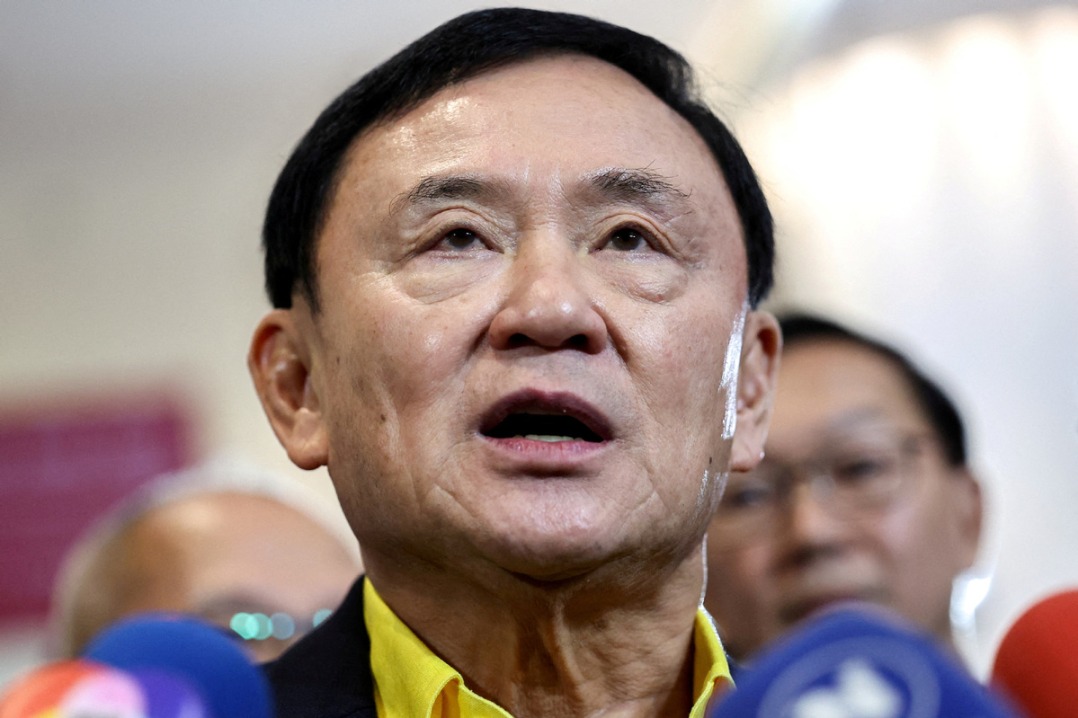True blue
China is actively deepening maritime cooperation with ASEAN in response to the strategic pressure from the US


As the strategic competition between China and the United States intensifies, Southeast Asia has become a key arena. And the maritime sector has become a key battleground where the US seeks to contain and counter China in this area.
To consolidate the US' maritime dominance in the Asia-Pacific region, the Joe Biden administration has pushed maritime issues in the region toward politicization, militarization and ideological confrontation. The US' "ASEANization" of maritime issues is especially evident after the Biden administration announced a $60 million commitment to support the implementation of the maritime pillar of the ASEAN outlook on the "Indo-Pacific" and launched new regional maritime initiatives.
Besides, the Biden administration aims to build an "Indo-Pacific "maritime alliance system. This system is hinged on alliances such as Washington's partnerships with Tokyo, Canberra and Manila, linked by frameworks such as the Quad (US-Japan-India-Australia) and AUKUS (Australia-UK-US), and constructed across the Indian and Pacific Oceans. It is supported by military actions from the US Navy and Coast Guard. This system has a clear objective of countering China and integrates a deterrence strategy against China. In contrast, China actively upholds a "dialogue rather than confrontation, partnership rather than alliance" approach, prioritizing cooperation with the Association of Southeast Asian Nations and focusing on neighboring countries and major powers to build a blue partnership network.
As a key participant in East Asian and broader regional governance, ASEAN has been promoting the solution of regional maritime issues through its cooperation framework centered on the "ASEAN plus "mechanism. Amid great power competition, ASEAN-led platforms are likely to become the only institutional option for dialogue aimed at peacefully resolving the regional maritime issues. However, the strategic competition between China and the US makes it difficult for ASEAN to demonstrate sufficient leadership and authority within its own maritime cooperation mechanisms, creating opportunities for Washington and Beijing to engage in the alignment of issues with the regional bloc and supplement regional maritime order construction.
First, ASEAN has not only expanded, institutionalized and standardized its internal defense cooperation but has also deepened defense cooperation with external major powers into sensitive areas. From 2018 to 2023, ASEAN member states conducted their first joint naval exercises with China, the US, Russia, and India, incorporating global and regional powers into ASEAN-led defense cooperation, thereby demonstrating ASEAN's influence and decision-making capability in defense matters.
Second, ASEAN tends to prioritize economic and nontraditional security issues with a focus on development and security, while de-emphasizing political and traditional security issues, the latter being the focus of attention from Washington. The US has been engaging Southeast Asian countries in large-scale naval exercises in the South China Sea, such as the US-Thailand Cobra Gold, US-Philippines Balikatan, US-Philippines Kamandag, and US-Indonesia Super Garuda Shield exercises. Additionally, the Pentagon is optimizing its military deployments in the region, including rotating Marine Corps units and military bases in Southeast Asia, to strengthen its forward military presence in the South China Sea and surrounding areas. Meanwhile, the China-led BRI adheres to a goal, action, and outcome-oriented approach, which has enhanced ASEAN's economic resilience and potential by strategically planning and implementing various initiatives. China tends to offer policy guidance and provide funding for the 10-nation bloc's economic and development plans, such as infrastructure projects like the New International Land-Sea Trade Corridor, the development of deep-water ports in Myanmar and container terminals in Cambodia.
To avoid choosing sides between China and the US, ASEAN tends to move forward with simultaneous cooperation with both countries, using balanced cooperation and corresponding reconciliation to offset the conflict risks brought by US militarization.
Rooted in shared visions, values, international law frameworks, and cooperative outcomes, the US "Indo-Pacific" strategy and the ASEAN outlook on the "Indo-Pacific" are increasingly converging and closely "aligned", making the "ASEANization" and the "Indo-Pacificization" convergence of regional maritime issues a possible risk. Additionally, as the maritime sector has become a crucial entry point for the US to contain China, Washington has sought to exacerbate disputes between China and neighboring countries over maritime boundaries and resources disputes, encouraging unilateral provocations by South China Sea claimants, and undermining the peaceful resolution of the disputes framework painstakingly formed by ASEAN and China. Against this backdrop, China is actively deepening maritime cooperation with ASEAN.
First, ASEAN-led platforms are important channels for resolving regional maritime issues, helping to alleviate regional tensions and enhance regional strategic autonomy. In October 2023, China and ASEAN completed the second review of the single draft negotiating text of the Code of Conduct in the South China Sea as scheduled. The third review on the negotiating text was also launched. This progress reflects that the power to set regional rules is in the hands of regional countries rather than hegemonic powers. It also helps to thwart attempts from the US to contain and encircle China with rules.
Second, China and ASEAN have undertaken a series of cooperative actions to develop and utilize maritime space and resources and address maritime security challenges. Both sides have relied on maritime connectivity construction to promote the development of ports, waterways, and logistics in Southeast Asia, coordinating the development of land, sea, air, and rail channels, and building a shipping network that is oriented toward ASEAN, linking the Indian and Pacific Oceans, and extending globally. Both sides have jointly launched and implemented the China-ASEAN Green Envoys Program and the 21st Century Maritime Silk Road Blue Carbon Program, conducting blue carbon projects such as preservation of coastal wetlands and mangrove forests and ecological fishery farming. Both sides have conducted maritime search and rescue tabletop exercises and joint maritime search and rescue drills, built a Southeast Asia marine environment forecasting and disaster warning system and promoted joint development with South China Sea claimant states. Multiple cooperation projects, such as China Petroleum and Chemical Corp's refineries in Johor, Malaysia, and Batam Island, Indonesia, as well as China National Offshore Oil Corp's deep-water gas field in South Sulawesi, Indonesia, have been launched. By providing technical and economic support in these cooperative actions, China demonstrates its firm commitment to regional peace, stability and development.
Finally, by establishing multilevel, multichannel communication, consultation and dialogue mechanisms with ASEAN and its member states, China can play a significant role in the formulation of regional maritime rules and maritime order, thereby enhancing its discourse power and leadership in regional affairs. In addition to high-level exchanges and dialogue mechanisms between leaders and maritime departments, China has also led the establishment of several mechanisms and platforms, such as the China-ASEAN Maritime Consultation Mechanism, China-ASEAN Marine Cooperation Center, China-ASEAN Port Cities Cooperation Network Forum, and the East Asia Marine Cooperation Platform, which serve as important links in building blue partnerships and a community of shared interests.
Zheng Xianwu is a professor and associate dean of the Institute of International Relations at Nanjing University. Tian Shihui is a doctoral candidate and research assistant at the institute. The authors contributed this article to China Watch, a think tank powered by China Daily. The views do not necessarily reflect those of China Daily.
Contact the editor at editor@chinawatch.cn.
































